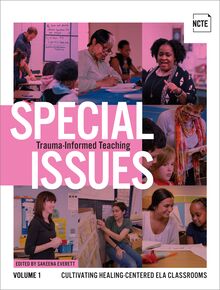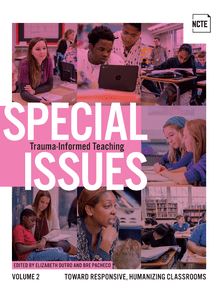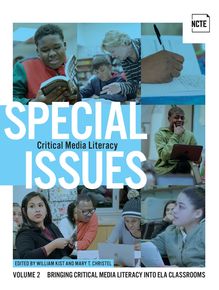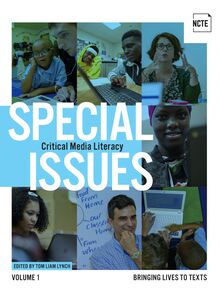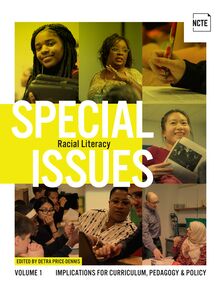Special Issues, Volume 2: Trauma-Informed Teaching , livre ebook
173
pages
English
Ebooks
2022
Vous pourrez modifier la taille du texte de cet ouvrage
Obtenez un accès à la bibliothèque pour le consulter en ligne En savoir plus
Découvre YouScribe en t'inscrivant gratuitement
Découvre YouScribe en t'inscrivant gratuitement
173
pages
English
Ebooks
2022
Vous pourrez modifier la taille du texte de cet ouvrage
Obtenez un accès à la bibliothèque pour le consulter en ligne En savoir plus
Date de parution
15 novembre 2022
Nombre de lectures
2
EAN13
9780814145111
Langue
English
07 Introduction: Trauma-Informed Teaching: Toward Responsive, Humanizing Classrooms
ELIZABETH DUTRO AND BRE PACHECO
LENSES FOR ATTENDING TO TRAUMA FOR EQUITY AND JUSTICE
13 Thirteen Ways of Looking at Trauma: Possibilities and Considerations for ELA Teachers
ADDISON DUANE AND ALEX SHEVRIN VENET
24 Racial Trauma Literacy for ELA Teachers in US Public Schools
ADAM J. ALVAREZ, YOLANDA SEALEY-RUIZ, AND ANGEL ACOSTA
34 Disrupting Damage-Centered Approaches to LGBTQ+ Inclusion: Finding Queer Possibilities
BETHY LEONARDI AND SARA STALEY
ATTUNING TO TRAUMA WITH AND FOR EDUCATORS
41 Making Space for Ourselves, Making Space for Each Other: Humanizing Practices in the ELA Classroom and in Teacher Education
BETINA HSIEH
46 “This Hit Me Like a Ton of Bricks”: A Case for Commonplace Journal Writing in Trauma Literature Pedagogy
AMBER MOORE
55 “Yet the embers still burn”: Teaching with Hope in a Broken World
CINDY O’DONNELL-ALLEN AND MOLLY ROBBINS
64 Stick and Stones: Toward Understanding the Trauma of Discursive Violence
KATHLEEN M. COLLINS
71 Knowing Someone: Descriptive Review to Support Children Who Have Experienced Trauma
CARA FURMAN
78 Teaching the Traumatized: Strategies Childhood Sex-Abuse Survivors Use in PreK–12 Literacy Classrooms
ANDIE CUNNINGHAM
PRACTICES TO SUPPORT TRAUMA-RESPONSIVE TEACHING
85 Interactive Read Alouds as Medicine: A Trauma-Informed, Healing-Centered Process for Humanizing Literacy Instruction
ARLÈNE ELIZABETH CASIMIR, HEIDI ALLUM, ERIN SILCOX, RHIANNON KIM, AND ADDISON DUANE
97 Cultivating Awe and Action: A Nature-Based Approach to Grief-Responsive, Trauma-Informed ELA Teaching
BRITTANY R. COLLINS
103 Transforming How We Trust: Actualizing Trauma-Informed, Arts-Based Instruction in ELA Classrooms
BRITTANY M. BREWER AND MAE EARLY
113 Reading Trauma: Uncovering Trauma Paradigms in Young Adult Literature
SARAH J. DONOVAN
125 Teaching Resilience in the English Classroom: A Path Forward
SHERRY PINEAU BROWN
135 A Rupture in Time
SARAH RICHARD
140 “Helping Students to Change Destiny”
KATHLEEN ANN GONZÁLEZ
Date de parution
15 novembre 2022
Nombre de lectures
2
EAN13
9780814145111
Langue
English
TITLES IN THE SERIES
CRITICAL MEDIA LITERACY
Vol. 1: Bringing Lives to Texts
Vol. 2: Bringing Critical Media Literacy into ELA Classrooms
RACIAL LITERACY
Vol. 1: Implications for Curriculum, Pedagogy, & Policy
Vol. 2: Sociopolitical and Sociocultural Contexts for Youth
TRAUMA-INFORMED TEACHING
Vol. 1: Cultivating Healing-Centered Classrooms
Vol. 2: Toward Responsive, Humanizing Classrooms
Editor: Elizabeth Dutro and Bre Pacheco
Series editor: James Sitar
Cover and interior design: Ash Goodwin
Cover images: Marvin Young
Typesetter: Jim Gallagher
ISBN: 978-0-8141-4503-6
eISBN: 978-0-8141-4511-1
© 2022 by the National Council of Teachers of English.
All rights reserved. No part of this publication may be reproduced or transmitted in any form or by any means, electronic or mechanical, including photocopy, or any information storage and retrieval system, without permission from the copyright holder. Printed in the United States of America.
It is the policy of NCTE in its journals and other publications to provide a forum for the open discussion of ideas concerning the content and the teaching of English and the language arts. Publicity accorded to any particular point of view does not imply endorsement by the Executive Committee, the Board of Directors, or the membership at large, except in announcements of policy, where such endorsement is clearly specified.
NCTE provides equal employment opportunity to all staff members and applicants for employment without regard to race, color, religion, sex, national origin, age, physical, mental or perceived handicap/disability, sexual orientation including gender identity or expression, ancestry, genetic information, marital status, military status, unfavorable discharge from military service, pregnancy, citizenship status, personal appearance, matriculation or political affiliation, or any other protected status under applicable federal, state, and local laws.
Every effort has been made to provide current URLs and email addresses, but, because of the rapidly changing nature of the web, some sites and addresses may no longer be accessible.
Library of Congress Cataloging-in-Publication Data applied for.
NCTE
340 N. Neil Street, Suite 104 | Champaign, IL 61820
www.ncte.org
TOWARD RESPONSIVE, HUMANIZING CLASSROOMS
Introduction: Trauma-Informed Teaching: Toward Responsive, Humanizing Classrooms
ELIZABETH DUTRO AND BRE PACHECO
LENSES FOR ATTENDING TO TRAUMA FOR EQUITY AND JUSTICE
Thirteen Ways of Looking at Trauma: Possibilities and Considerations for ELA Teachers
ADDISON DUANE AND ALEX SHEVRIN VENET
Racial Trauma Literacy for ELA Teachers in US Public Schools
ADAM J. ALVAREZ, YOLANDA SEALEY-RUIZ, AND ANGEL ACOSTA
Disrupting Damage-Centered Approaches to LGBTQ+ Inclusion: Finding Queer Possibilities
BETHY LEONARDI AND SARA STALEY
ATTUNING TO TRAUMA WITH AND FOR EDUCATORS
Making Space for Ourselves, Making Space for Each Other: Humanizing Practices in the ELA Classroom and in Teacher Education
BETINA HSIEH
“This Hit Me Like a Ton of Bricks”: A Case for Commonplace Journal Writing in Trauma Literature Pedagogy
AMBER MOORE
“Yet the embers still burn”: Teaching with Hope in a Broken World
CINDY O’DONNELL-ALLEN AND MOLLY ROBBINS
Stick and Stones: Toward Understanding the Trauma of Discursive Violence
KATHLEEN M. COLLINS
Knowing Someone: Descriptive Review to Support Children Who Have Experienced Trauma
CARA FURMAN
Teaching the Traumatized: Strategies Childhood Sex-Abuse Survivors Use in PreK–12 Literacy Classrooms
ANDIE CUNNINGHAM
PRACTICES TO SUPPORT TRAUMA-RESPONSIVE TEACHING
Interactive Read Alouds as Medicine: A Trauma-Informed, Healing-Centered Process for Humanizing Literacy Instruction
ARLÈNE ELIZABETH CASIMIR, HEIDI ALLUM, ERIN SILCOX, RHIANNON KIM, AND ADDISON DUANE
Cultivating Awe and Action: A Nature-Based Approach to Grief-Responsive, Trauma-Informed ELA Teaching
BRITTANY R. COLLINS
Transforming How We Trust: Actualizing Trauma-Informed, Arts-Based Instruction in ELA Classrooms
BRITTANY M. BREWER AND MAE EARLY
Reading Trauma: Uncovering Trauma Paradigms in Young Adult Literature
SARAH J. DONOVAN
Teaching Resilience in the English Classroom: A Path Forward
SHERRY PINEAU BROWN
A Rupture in Time
SARAH RICHARD
“Helping Students to Change Destiny”
KATHLEEN ANN GONZÁLEZ
TRAUMA-INFORMED TEACHING: Toward Responsive, Humanizing Classrooms
ELIZABETH DUTRO AND BRE PACHECO
WHEN WE THINK ABOUT TRAUMA in the context of the lives that animate schools, we start here: Teachers and students begin their day as humans and end their day as humans. What happens during school hours impacts children's, youth's, and teachers' opportunities to have their humanity recognized and affirmed or to be made to feel inadequate, invisible, or unworthy of respect and care. We know these statements are not in dispute. Yet, we also know that in systems steeped in histories of injustice and invested in narrow quantifiable ways of measuring and categorizing achievement and success, acting toward the affirming and humanizing in schooling is never a given. Experiences of pain, sorrow, loss, fear, disruption, and systemic and institutional oppression are an inevitable presence in schools and classrooms. We join colleagues within and far beyond the pages in this volume in our belief that trauma-informed teaching, with all of the complex layers that term contains, can and must be harnessed to propel movements toward equity and justice in English language arts classrooms.
As we launch Volume 2 of the Special Issues series on trauma-informed teaching, we hope readers have also delved into the powerful collection of previously published writing related to this area of the field in Volume 1, edited by Dr. Sakeena Everett. That volume curated recent articles from across NCTE journals as a resource for ELA educators. This second volume joins that effort through this collection of chapters by authors who submitted their work in response to our call. The chapters that follow reflect multiple conversations and voices in our profession. This volume's pages are filled with expe-riences, lenses, pedagogies, and practices arising from K–12 classrooms, spaces of teacher learning and collaboration, and partnerships with families and communities. Woven throughout, authors share stories from life and literature that aptly show the power and possibility of ELA classrooms for enacting the deepest hopes that fuel the year to year, day to day, moment to moment enactment of humanizing, healing teaching.
In compiling this collection of insights from ELA educators across grade levels and contexts of work with students, we have felt the presence of interwoven themes, including: knowledge, story, justice, healing, and complexity. Guided by these themes, we begin this introduction by situating ourselves in relation to this work and this volume within the historical moment in which it arrives. We then highlight some of the ideas related to trauma and ELA classrooms that animate our own and this Special Issue's commitments. We then turn to the chapters readers will encounter, briefly pointing to each chapter to capture the range of contexts, ideas, and resources ELA educators will find.
Situating Ourselves and This Volume WHO WE ARE
We met through a mutual colleague in 2015 and, since then, have collaborated on two school-university partnerships. We each bring investments to trauma-informed policy and practice from our distinct positions and in our shared work to support and collaborate with teacher colleagues in bringing their creativity and commitments to practice amidst all of the pressures they have to navigate. Bre writes as a cisgendered, queer, Indigenous and European woman. She has spent the past fifteen years as an elementary teacher, instructional coach, and social emotional learning specialist in Title I schools. She has two young boys in elementary school who have inherited the call for justice. Together, they spend nights reading books that inspire hope, resistance, and resilience. They talk deeply about the small and big actions they want to take and reflect on actions that have already been taken. This begins part of the critical thinking and planning of lessons that transfer into the classroom. Elizabeth writes as a white, cis, straight woman, a former elementary teacher and longtime literacy professor. In her collaborations with teacher colleagues and children, and as parent to two queer biracial Asian American young adults, she strives to be a coconspirator toward justice. Fifteen years ago, she started studying humanities-centered trauma studies and what it might offer critical literacy research and practice. Our work together on this volume and separately has allowed us to hold onto possibilities, conundrums, hopes, and curiosities within this area of the field.
EMBODIED KNOWLEDGE, TRAUMA, AND THE HISTORICAL MOMENT
What might we consider and pursue when we hold the themes of knowledge, story, healing, justice, and complexity in concert with the goal of attuning to trauma in responsive, humanizing ways in classrooms? As Chicanx queer theorist and writer Gloria Anzaldúa writes, “The material body is center, and central. The body is the ground of thought” (5). The body as knowledge holder is always reading, writing, and rewriting stories that are steeped in personal, familial, community, and cultural histories. Given that all forms of knowledge held by bodies matter, some of that knowledge is, of course, gleaned through trauma. As those stories are lived within and beyond schools, they are encountered and interpreted by others in ways that hold potential to foster vibrant, healing connections and perpetuate pain and harm. Central to the aims of this volume is the idea that difficult knowledge, born of trauma, not only must count as knowledge but is central to seeing the world for what it is and what it could be.
A vision for
